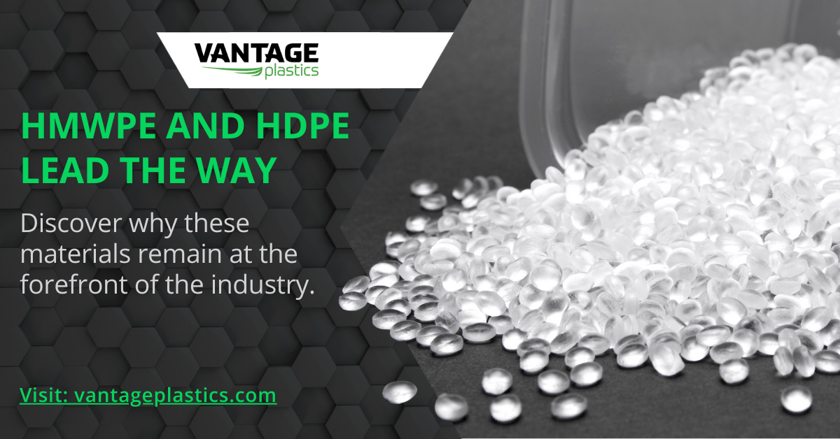Why Injection Molding Matters At Lotis Lotis Technologies is the injection molding powerhouse in...
Why HMWPE and HDPE are Common Plastic Thermoforming Materials

The versatility, durability, and toughness of HMWPE and HDPE is a key factor in their widespread adoption. Thermoforming allows these materials to be easily shaped into complex geometries, opening up a broad range of design possibilities for manufacturers. Both materials can be molded from simple packaging products to intricate automotive components to meet diverse industry needs.
WHAT ARE THE DIFFERENCES BETWEEN HMWPE AND HDPE?
HMWPE and HDPE are both commonly used plastic materials in thermoforming, but they differ in various aspects. HMWPE’s higher molecular weight grants it exceptional toughness and impact resistance, making it suitable for automotive parts, recreational products, and industrial containers. Conversely, HDPE’s lower molecular weight provides flexibility, making it ideal for packaging materials like bottles and containers.
HMWPE offers superior chemical resistance, while HDPE is more cost-effective due to its lower production costs. Both materials are recyclable. The choice between the two depends on specific application requirements, with HMWPE excelling in structural integrity and HDPE excelling in flexibility and affordability.
HIGH MOLECULAR WEIGHT POLYETHYLENE (HMWPE)
High Molecular Weight Polyethylene, or HMWPE, is a type of polyethylene characterized by its high molecular weight and long chains of polymer molecules. This attribute contributes to its exceptional toughness, stiffness, and durability, making it a preferred choice for numerous applications. Here are some of the key reasons why HMWPE is favored in plastic thermoforming:
Superior Impact Resistance: HMWPE can endure heavy blows and shock without experiencing deformation or breaking. This property makes it an ideal material for products requiring high structural integrity, such as pallets, automotive parts, industrial containers, and recreational equipment. Manufacturers can confidently produce items that can withstand harsh operating conditions, providing reliable solutions.
Chemical and Corrosion Resistance: HMWPE exhibits excellent resistance to chemicals and corrosive substances, making it an ideal choice for applications where exposure to harsh environments is expected. Industries such as chemical processing, pharmaceuticals, and agriculture benefit from the material’s ability to withstand chemical contact without undergoing significant deterioration. HMWPE’s resilience ensures that products retain their integrity and do not pose risks related to chemical leakage or contamination. HMWPE is also a material that is relatively easy to clean. Many HMWPE pallets are cleaned with industrial washing systems after each usage.
Cost-Effective Solution: Despite its impressive performance characteristics, HMWPE offers a cost-effective solution for various applications. Its durability and longevity result in low maintenance costs and reduced need for early replacement, making it an economically viable choice for manufacturers and end-users. The balance between performance and affordability makes HMWPE an attractive option for companies seeking sustainable, budget-friendly solutions. Once an HMWPE product reaches its end-of-need stage, they are easily recyclable, so the material can be used to make new products. Vantage Plastics guarantees to buy back any product we manufacture for its material value once it has reached the end of its useful life.
Ease of Thermoforming: HMWPE’s high molecular weight and amorphous structure make it relatively easy to thermoform using various techniques such as vacuum forming and pressure forming. This ease of processing translates into higher production efficiency and reduced manufacturing costs. The ability to form complex shapes with precision enables manufacturers to design and produce custom-made products according to specific requirements, further expanding the application potential of HMWPE in the thermoforming industry.
HIGH-DENSITY POLYETHYLENE (HDPE)
High-Density Polyethylene (HDPE) is another widely-used thermoplastic that stands out for its high strength-to-density ratio. This versatile material boasts several characteristics that contribute to its popularity in the thermoforming industry:
Lightweight and Flexible: HDPE’s lightweight and flexible nature makes it an ideal choice for applications where easy handling and transport are essential. It is frequently used to produce packaging materials such as bottles, containers, and lids. Its ability to be easily molded into various shapes and sizes enhances its appeal for packaging applications, providing manufacturers with a cost-effective and user-friendly solution.
Excellent Chemical Resistance: Like HMWPE, HDPE exhibits exceptional resistance to chemicals, further expanding its application range in various industries. It is commonly utilized in chemical processing equipment, storage tanks, and pipework, where resistance to chemical exposure is crucial. The material’s resilience ensures the safety and integrity of stored chemicals and prevents potential hazards associated with chemical leaks or spillages.
Food-Grade Compatibility: HDPE’s inherent food-grade compatibility has contributed significantly to its widespread use in the food and beverage industry. It is considered safe for food contact applications, making it an excellent choice for packaging food products such as milk jugs, juice bottles, and food containers. Its non-toxic, odorless, and low-temperature withstanding properties assure consumers that the packaged products remain untainted and safe for consumption.
Recyclability: HDPE, like HMWPE, is highly recyclable, aligning with the growing emphasis on environmental sustainability. The ability to recycle HDPE reduces the demand for virgin plastic production and minimizes plastic waste in landfills and oceans. As environmental consciousness continues to grow, the recyclability of HDPE positions it as an eco-friendly choice for both manufacturers and consumers.
WE UTILIZE HMWPE AND HDPE AT VANTAGE PLASTICS
As manufacturing technologies progress, HMWPE and HDPE will likely remain at the forefront of the thermoforming industry, offering innovative solutions for industrial processes and consumer needs. At Vantage Plastics, we take pride in using the best thermoforming materials, including HMWPE and HDPE. Whether you require automotive components, industrial containers, or packaging materials, our experienced team can meet your specific needs. We work closely with material compounders to develop custom material blends to meet the requirements of certain product applications.
Contact us today for a personalized quote and discover the reliable and cost-effective solutions we offer for your next thermoforming project. Unlock the full potential of thermoforming with Vantage Plastics.
